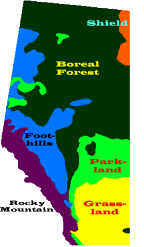Rocky Mountain Region: Alberta, Canada
Banff, Canada's first national park, was established in 1885. Soon after, Waterton Lakes National Park was established on the southern end and Jasper National Park on the northern end of Alberta's Rocky Mountain Chain. And, in 1959, the Government of Alberta protected another significant mountain region, Willmore Wilderness Park, just north of Jasper National Park. Willmore Wilderness Park - Eagle's Nest Pass
Unfortunately, the task of protecting the Rocky Mountain region's full range of natural diversity rests more than anything else on the third sub-region, the Montane, which today remains largely unprotected. In the Rocky Mountains, the Montane sub-region exists only in the low-elevation mountain valleys of the Athabasca, North Saskatchewan, Red Deer and Bow rivers. Another small area of Montane exists in a narrow band of the foothills region in southwestern Alberta. The Montane sub-region has mild winters, warm summers and diverse vegetation. Open areas are covered with grasses. Rocky or sheltered areas are covered with douglas fir, aspen, white spruce or limber pine. In the valley bottoms, streams meander through rich wetlands of willow, sedge and spruce and are dammed by beavers producing important wetlands. This critically important sub-region supports large populations of wildlife that are not found in abundance in the province. Endangered and vulnerable species include the woodland caribou, grizzly bear, wolverine, Cooper's hawk, and the great gray owl. For these reasons, the Montane sub-region is the most ecologically significant part of the Rocky Mountain Natural Region. The threat to the Montane sub-region is obvious -- it's the focus of most of our intensive tourism development in the mountains -- townsites, lodges, roads and golf courses are all located in the Montane, which is the smallest of the three sub-regions. And, such is the pressure for additional development that this sub-region can not be considered to be truly protected, even in the National Parks. According to a recent scientific report, Banff National Park, the most blatant example of overdevelopment, now stands to to lose many of the species that its many visitors value and enjoy viewing. In sum, you will often hear developers claim that most of Jasper and Banff National Parks are undeveloped. While true, the most important and smallest mountain sub-region, the montane, is all but gone to a sea of development and development proposals. |
|
Want to help protect the Rocky Mountains?
|
Other Rocky Mountain Webpages:
|
Foothill Region |
Grassland Region |
Mountain Region |
|
Shield Region |
 Located
in the Southwestern edge of Alberta, the Rocky Mountains are perhaps the best
known and most well visited of Alberta's six natural regions. The Rocky Mountains
comprise 8 percent of the province.
Located
in the Southwestern edge of Alberta, the Rocky Mountains are perhaps the best
known and most well visited of Alberta's six natural regions. The Rocky Mountains
comprise 8 percent of the province.  The
foresight of those who set aside these parks ensured that two of the three sub-regions
of the Rocky Mountains, the Alpine and Sub-Alpine, are well protected today. These
high elevation habitats have short growing seasons, rugged winters and low biological
productivity. To maintain viable populations, mountain wildlife like goats and
big horn sheep need more habitat than animals that live in more benign environments
at lower elevations. Therefore, it's fortunate that such large areas were protected.
The
foresight of those who set aside these parks ensured that two of the three sub-regions
of the Rocky Mountains, the Alpine and Sub-Alpine, are well protected today. These
high elevation habitats have short growing seasons, rugged winters and low biological
productivity. To maintain viable populations, mountain wildlife like goats and
big horn sheep need more habitat than animals that live in more benign environments
at lower elevations. Therefore, it's fortunate that such large areas were protected.



